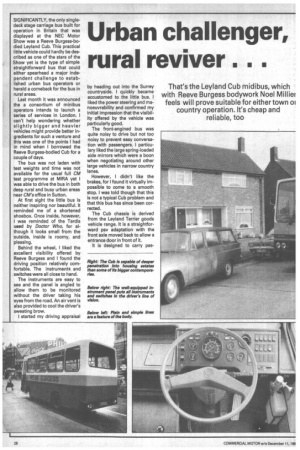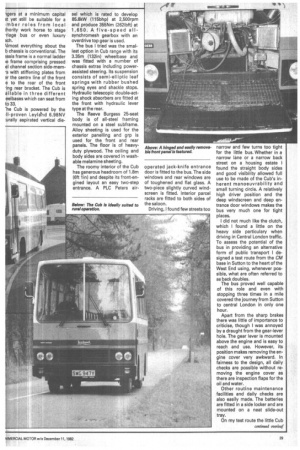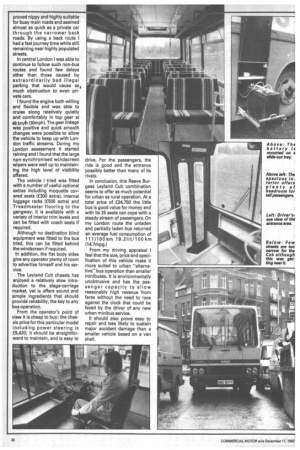Urban challenger, rural reviver. . .
Page 24

Page 25

Page 26

If you've noticed an error in this article please click here to report it so we can fix it.
That's the Leyland Cub midibus, which with Reeve Burgess bodywork Noel Millier feels will prove suitable for either town or country operation. It's cheap and reliable, too
SIGNIFICANTLY, the only singledeck stage carriage bus built for operation in Britain that was displayed at the NEC Motor Show was a Reeve Burgess-bodied Leyland Cub. This practical little vehicle could hardly be described as one of the stars of the Show yet is the type of simple straightforward bus that could either spearhead a major independent challenge to established urban bus operators or herald a comeback for the bus in rural areas.
Last month it was announced the a consortium of minibus operators intends to launch a series of services in London. I can't help wondering whether slightly bigger and heavier vehicles might provide better ingredients for such a venture and this was one of the points I had in mind when I borrowed the Reeve Burgess-bodied Cub for a couple of days.
The bus was not laden with test weights and time was not available for the usual full CM test programme at MIRA yet I was able to drive the bus in both deep rural and busy urban areas near CM's office in Sutton.
At first sight the little bus is neither inspiring nor beautiful. It reminded me of a shortened shoebox. Once inside, however. I was reminded of the Tardis used by Doctor Who, for although it looks small from the outside, inside is roomy, and pleasing.
Behind the wheel, I liked the excellent visibility offered by Reeve Burgess and I found the driving position relatively comfortable. The instruments and switches were all close to hand.
The instruments are easy to see and the panel is angled to allow them to be monitored without the driver taking his eyes from the road. An air vent is also provided to cool the driver's sweating brow.
I started my driving appraisal by heading out into the Surrey countryside. I quickly became accustomed to the little bus. I liked the power steering and manoeuvrability and confirmed my initial impression that the visibility offered by the vehicle was particularly good.
The front-engined bus was quite noisy to drive but not too noisy to prevent easy conversation with passengers. I particulary liked the large spring-loaded side mirrors which were a boon when negotiating around other large vehicles in narrow country lanes.
However, I didn't like the brakes, for I found it virtually impossible to come to a smooth stop. I was told though that this is not a typical Cub problem and that this bus has since been corrected.
The Cub chassis is derived from the Leyland Terrier goods vehicle range. It is a straightforward pay adaptation with the front axle moved back to allow a entrance door in front of it.
It is designed to carry pas Niers at a minimum capital it yet still be suitable for a Imber roles from local thority work horse to stage liege bus or even luxury
3ch.
klmost everything about the b chassis is conventional. The Issis frame is a normal ladder le frame comprising pressed el channel section side-mem's with stiffening plates from )r the centre line of the front e to the rear of the front ing rear bracket. The Cub is ailable in three different eelbases which can seat from to 33.
he Cub is powered by the II-proven Leylihd 6.98NV 'urally aspirated vertical die
sel which is rated to develop 85.8kW 1.15bhp) at 2,500rpm and produce 355Nm (262Ibft) at 1,6 5 O. A five-speed allsynchromesh gearbox with an overdrive top gear is used.
The bus I tried was the smallest option in Cub range with its 3.35m (1321n) wheelbase and was fitted with a number of chassis extras including powerassisted steering. Its suspension consists of semi-elliptic leaf springs with rubber bushed spring eyes and shackle stops. Hydraulic telescopic double-acting shock absorbers are fitted at the front with hydraulic lever type at the rear.
The Reeve Burgess 25-seat body is of all-steel framing mounted on a steel subframe. Alloy sheeting is used for the exterior panelling and grp is used for the front and rear panels. The floor is of heavyduty plywood. The ceiling and body sides are covered in washable melamine sheeting.
The roomy interior of the Cub has generous headroom of 1.8m (6ft 1in) and despite its front-engined layout an easy two-step entrance. A PLC Peters air operated jack-knife entrance door is fitted to the bus. The side windows and rear windows are of toughened and flat glass. A two-piece slightly curved windscreen is fitted. Interior parcel racks are fitted to both sides of the saloon.
Driving, I found few streets too narrow and few turns too tight for the little bus. Whether in a narrow lane or a narrow back street on a housing estate found the straight body sides and good visibility allowed full use to be made of the Cub's in herent manoeuvrability and small turning circle. A relatively high driver position and the deep windscreen and deep entrance door windows makes the bus very much one for tight places.
I did not much like the clutch, which I found a little on the heavy side particulary when driving in Central London traffic. To assess the potential of the bus in providing an alternative
form of public transport I designed a test route from the CM
base in Sutton to the heart of the West End using, whenever possible, what are often referred to as back doubles.
The bus proved well capable of this role and even with stopping three times in a mile covered the journey from Sutton to central London in only one hour.
Apart from the sharp brakes there was little of importance to criticise, though I was annoyed by a draught from the gear-lever hole. The gear lever is mounted above the engine and is easy to reach and use. However, its position makes removing the en gine cover very awkward. In fairness to the design, all daily checks are possible without re moving the engine cover as there are inspection flaps for the oil and water.
Other routine maintenance facilities and daily checks are also easily made. The batteries are fitted in a side locker and are mounted on a neat slide-out tray.
On my test route the little Cub proved nippy and highly suitable for busy main roads and seemed almost as quick as a private car through the narrower back roads. By using a back route I had a fast journey time while still remaining near highly populated streets.
In central London I was able to continue to follow such non-bus routes and found few delays other than those caused by extraordinarily bad illegal parking that would cause as, much obstruction to even private cars.
I found the engine both willing and flexible and was able to cruise along relatively quietly and comfortably in top gear at 48 kmk (30mph). The gear linkage was positive and quick smooth changes were possible to allow the vehicle to keep up with London traffic streams. During my London assessment it started raining and I found that the large non-synchronised windscreen wipers were well up to maintaining the high level of visibility offered.
The vehicle I tried was fitted with a number of useful optional extras including moquette covered seats (£300 extra), internal luggage racks (£500 extra) and Treadmaster flooring to the gangway. It is available with a variety of interior trim levels and can be fitted with coach seats if required.
Although no destination blind equipment was fitted to the bus tried, this can be fitted behind the windscreen if required.
In addition, the flat body sides give any operator plenty of room to advertise himself and his service.
The Leyland Cub chassis has enjoyed a relatively slow introduction to the stage-carriage market, yet is offers sound and simple ingredients that should provide. reliability, the key to any bus operation.
From the operator's point of view it is cheap to buy; the chassis price for this particular model including power steering is £9,420; it should be straightforward to maintain, and is easy to drive. For the passengers, the ride is good and the entrance possibly better than many of its rivals.
In conclusion, this Reeve Burgess Leyland Cub combination seems to offer as much potential for urban as rural operation. At a total price of £24,750 the little bus is good value for money and with its 25 seats can cope with a steady stream of passengers. On my London route the unladen and partially laden bus returned an average fuel consumption of 111)100 km 19.21it/100 km (14.7mpg.) From my driving appraisal I feel that the size, price and specification of this vehicle make it more suited to urban "alternative" bus operation than smaller minibuses. It is environmentally unobtrusive and has the passenger capacity to allow reasonably high revenue from fares without the need to race against the clock that could be faced by the driver of any new urban minibus service.
It should also prove easy to repair and less likely to sustain major accident damage than a smaller vehicle based on a van shell.
































































